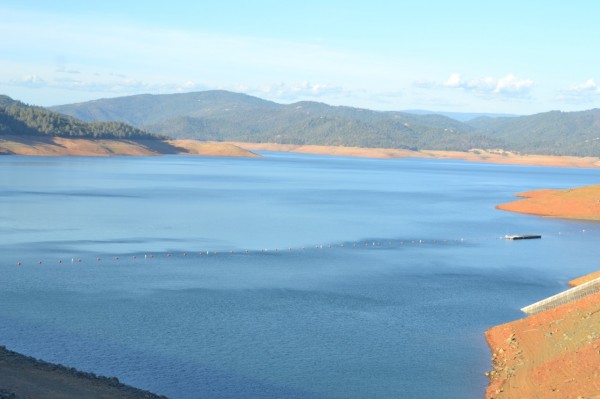There’s one question that keeps coming up as we continue our Real Food farm tour project. Why should consumers care about or get to know about farm water? And what does it have to do with our food and where it comes from?

Water at the Oroville Dam
We’ve learned a great deal about farm water in the past few months. The California Farm Water Coalition (“Food grows where water flows”) has helped by giving us a big-picture look at California’s 81,500 farms. Those farms share a common thread in needing water to survive. There’s a big misconception that farms are a huge drain on water supplies, when in fact farms use water more efficiently now than ever.

A bypass canal at the Glenn-Colusa Irrigation District
Water Flowing in California
Here’s how it works in California: The state gets about 200 million acre-feet (one acre-foot of water is what it would take to fill one acre up to one feet deep) of rain, snowfall, and inflow from the Colorado and Klamath rivers per year. About 50 to 60 percent of that goes to natural vegetation, evaporates, or flows out of state. That leaves about 40 to 50 percent for California’s residential water users, agricultural users, and dedicated environmental purposes. An extensive system of dams, aqueducts, canals, and reservoirs connects the water to people, farms, and wildlife refuges throughout the state.
Using Water More Efficiently
How do farmers use water? Very efficiently – in fact, they’ve doubled the economic efficiency of agricultural water supplies over the past 40 years. Another way of looking at it is this: If they use too much, it can hurt the plants and cost farmers money. For example, many people have the idea that rice is a “monsoon” crop; whereas most California rice grows with a minimum of water. The average depth of water in a rice field during growing season is only five inches. Last week at Lundberg’s rice farm we got a chance to see first-hand how the soil conditions (heavy clay with hardpan underneath) are perfect for holding water in place.

100-year-old olive trees at Lodestar Farms
Water needs vary depending on the kind of farm and the type of soil on the farm, but one consistent theme is that every farmer is conscientious about water. At one farm we visited, Lodestar Farms in Oroville, the 100-year-old olive trees can survive on little water if needed. (The olives will grow slower and not quite as large, but they can survive.) The Chico-based Sierra Nevada brewery, which has its own hops and barley fields, treats all of its production wastewater. Its water usage is now down to about half the typical usage of breweries in the U.S.

Not beer yet: These brilliant green hops sit in the drying room at the Sierra Nevada brewery
Now consider this – If farms don’t get the water they need, their crops (and food) become more expensive. Given that’s it’s been a relatively dry year, how will the price of farm-fresh foods reflect that change? Will you think of farm water next time you eat a piece of fruit?

 Hi! I'm Jeanne Fratello - a writer, reporter, and food enthusiast who is on a mission to write great stories about food and where your food comes from.
Hi! I'm Jeanne Fratello - a writer, reporter, and food enthusiast who is on a mission to write great stories about food and where your food comes from. 
No comments yet.